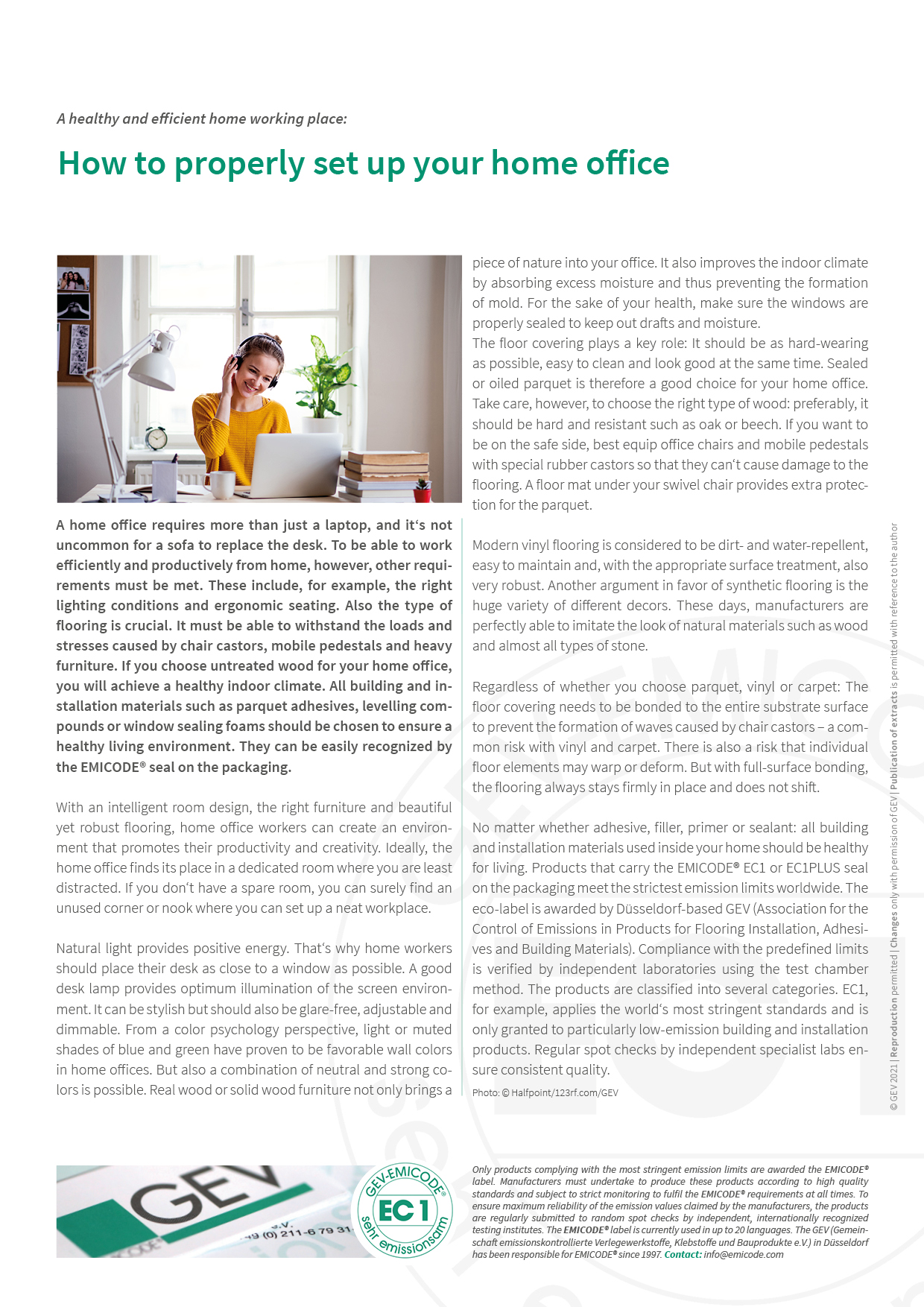How to properly set up your home office
A healthy and efficient home working place
A home office requires more than just a laptop, and it’s not uncommon for a sofa to replace the desk. To be able to work efficiently and productively from home, however, other requirements must be met. These include, for example, the right lighting conditions and ergonomic seating. Also the type of flooring is crucial. It must be able to withstand the loads and stresses caused by chair castors, mobile pedestals and heavy furniture. If you choose untreated wood for your home office, you will achieve a healthy indoor climate. All building and installation materials such as parquet adhesives, levelling compounds or window sealing foams should be chosen to ensure a healthy living environment. They can be easily recognized by the EMICODE® seal on the packaging.
With an intelligent room design, the right furniture and beautiful yet robust flooring, home office workers can create an environment that promotes their productivity and creativity. Ideally, the home office finds its place in a dedicated room where you are least distracted. If you don’t have a spare room, you can surely find an unused corner or nook where you can set up a neat workplace.
Natural light provides positive energy. That’s why home workers should place their desk as close to a window as possible. A good desk lamp provides optimum illumination of the screen environment. It can be stylish but should also be glare-free, adjustable and dimmable. From a color psychology perspective, light or muted shades of blue and green have proven to be favorable wall colors in home offices. But also a combination of neutral and strong colors is possible. Real wood or solid wood furniture not only brings a piece of nature into your office. It also improves the indoor climate by absorbing excess moisture and thus preventing the formation of mold. For the sake of your health, make sure the windows are properly sealed to keep out drafts and moisture.
The floor covering plays a key role: It should be as hard-wearing as possible, easy to clean and look good at the same time. Sealed or oiled parquet is therefore a good choice for your home office. Take care, however, to choose the right type of wood: preferably, it should be hard and resistant such as oak or beech. If you want to be on the safe side, best equip office chairs and mobile pedestals with special rubber castors so that they can’t cause damage to the flooring. A floor mat under your swivel chair provides extra protection for the parquet.
Modern vinyl flooring is considered to be dirt- and water-repellent, easy to maintain and, with the appropriate surface treatment, also very robust. Another argument in favor of synthetic flooring is the huge variety of different decors. These days, manufacturers are perfectly able to imitate the look of natural materials such as wood and almost all types of stone.
Regardless of whether you choose parquet, vinyl or carpet: The floor covering needs to be bonded to the entire substrate surface to prevent the formation of waves caused by chair castors – a common risk with vinyl and carpet. There is also a risk that individual floor elements may warp or deform. But with full-surface bonding, the flooring always stays firmly in place and does not shift.
No matter whether adhesive, filler, primer or sealant: all building and installation materials used inside your home should be healthy for living. Products that carry the EMICODE® EC1 or EC1PLUS seal on the packaging meet the strictest emission limits worldwide. The eco-label is awarded by Düsseldorf-based GEV (Association for the Control of Emissions in Products for Flooring Installation, Adhesives and Building Materials). Compliance with the predefined limits is verified by independent laboratories using the test chamber method. The products are classified into several categories. EC1, for example, applies the world’s most stringent standards and is only granted to particularly low-emission building and installation products. Regular spot checks by independent specialist labs ensure consistent quality.

Photo: ©Halfpoint/123rf.com/GEV
It is a well-known fact that colors and lighting conditions influence our psyche. The home workplace should therefore be positioned as close to the window as possible. The most preferable wall colors are light or muted shades of blue and green. Furniture and flooring made of real wood improve the indoor climate. If you attach great importance to a healthy home, you should exclusively use low-emission building and installation materials. You can identify them by the EMICODE® seal.

Do You Have Questions?
If you have any questions on certain topics or want to contact us for another reason, please contact us by phone or email.
Phone: +49 (0)211 843 449 – 01
info@emicode.com
Share article on Social Media:
